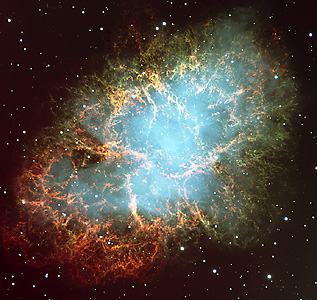Nova is an explosion that causes a star to become from 10,000 to 100,000 times as bright as the sun. The star may shine this brightly for a week, a month, or longer before fading to its original brightness. A nova hurls huge masses of gas and dust into space. The word nova comes from the Latin word for new. People once mistook novae for new stars.

Stars that undergo fast novae reach their maximum brightness several hours after the explosion. They begin to fade after a few days. Stars that undergo slow novae take much longer to reach their maximum brightness. However, they stay extremely bright for months or even years before they fade to their original brightness. Fast novae propel gas and dust outward at speeds of several thousand miles or kilometers per second. Slow novae do so about a tenth as fast.
Loading the player...Fermi Gamma-ray Space Telescope
Astronomers believe that novae occur in close binaries. A close binary is a double star system in which two stars revolve closely around each other (see Binary star). For a nova to occur, one of the stars must be medium-sized, and the other must be a small, extremely dense star called a white dwarf. The two stars are so close that the gravitational pull of the white dwarf draws material rich in hydrogen from the larger star. This material collects on the white dwarf and eventually triggers reactions of nuclear fusion there. In such reactions, hydrogen nuclei combine to form helium nuclei, and a large amount of energy is released. The reactions quickly become a runaway process, which results in a nova. In 2010, scientists using NASA’s Fermi Gamma-ray Space Telescope discovered that novae can emit high energy rays called gamma rays.

During the last 100 years, astronomers have observed some stars that have undergone more than one nova. Astronomers call such explosions recurrent novae. All novae may be recurrent, but for some of them the interval between explosions may be hundreds or even thousands of years. This much time may be required for a white dwarf to accumulate enough hydrogen for nuclear fusion to recur. On the other hand, the causes of recurrent and ordinary novae may differ, and ordinary novae may occur only once in a close binary.
Some close binaries undergo small explosions every month or so. These dwarf novae do not throw out material during an outburst, and they become only 10 to 100 times as bright as the sun. Their cause is unknown. Other stars undergo explosions called supernovae, which are thousands of times as bright as ordinary novae. Some supernovae occur in binaries, while others result from the collapse of extremely massive stars.
See also Supernova; White dwarf.
